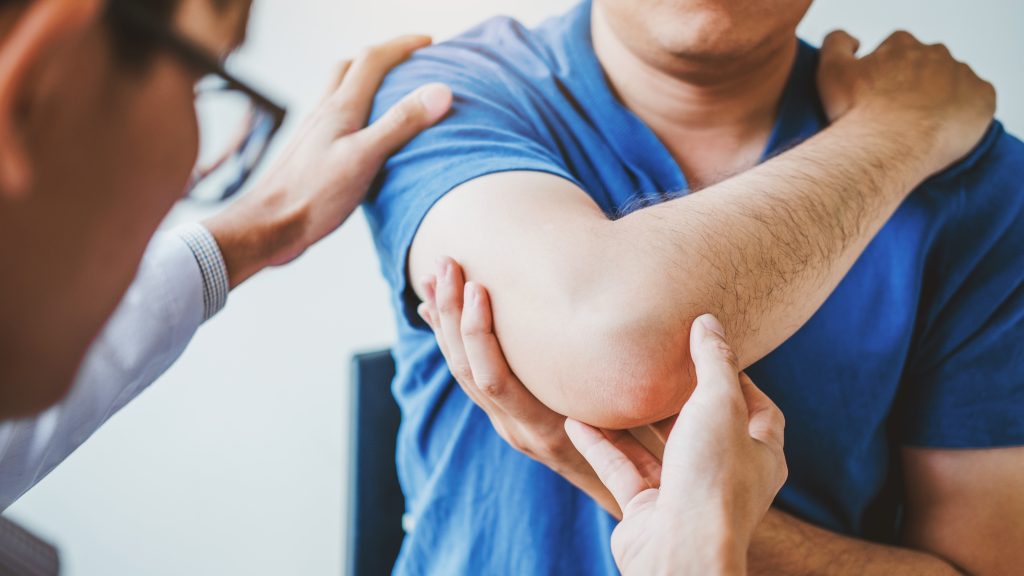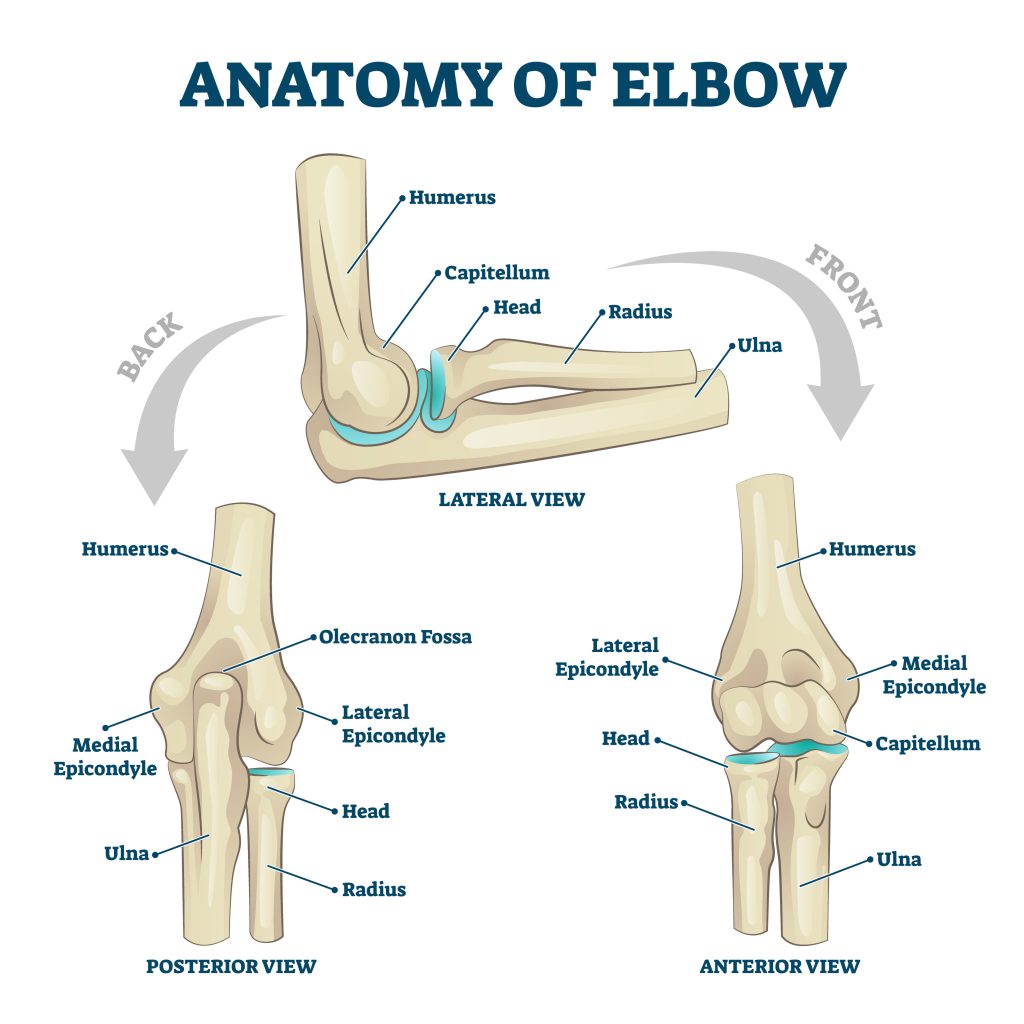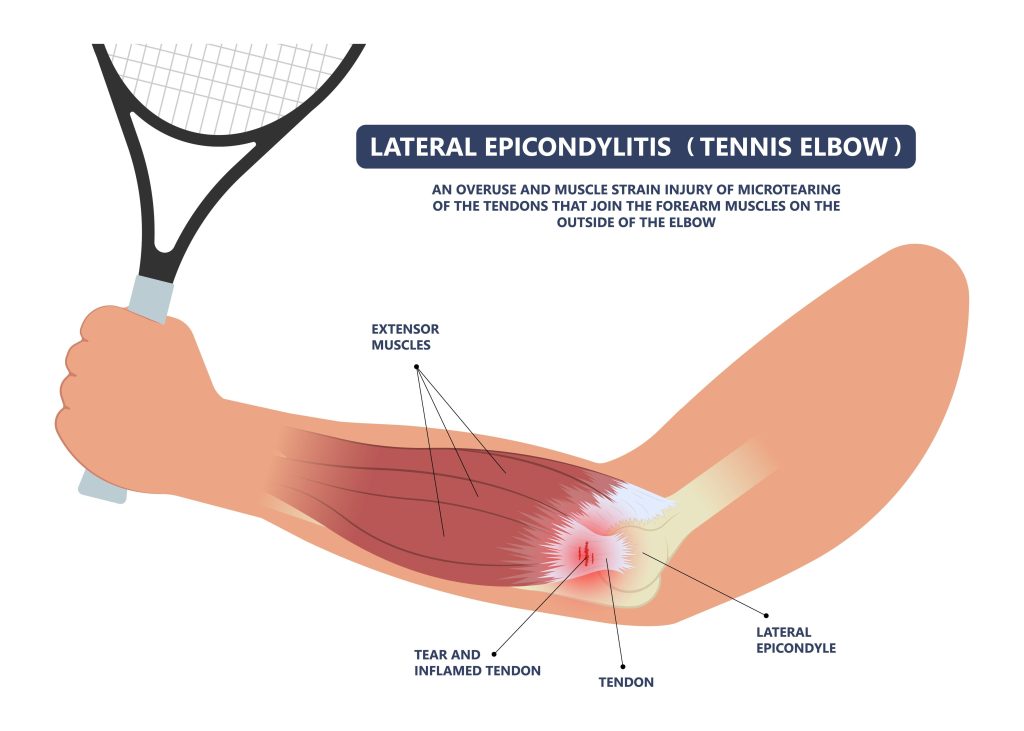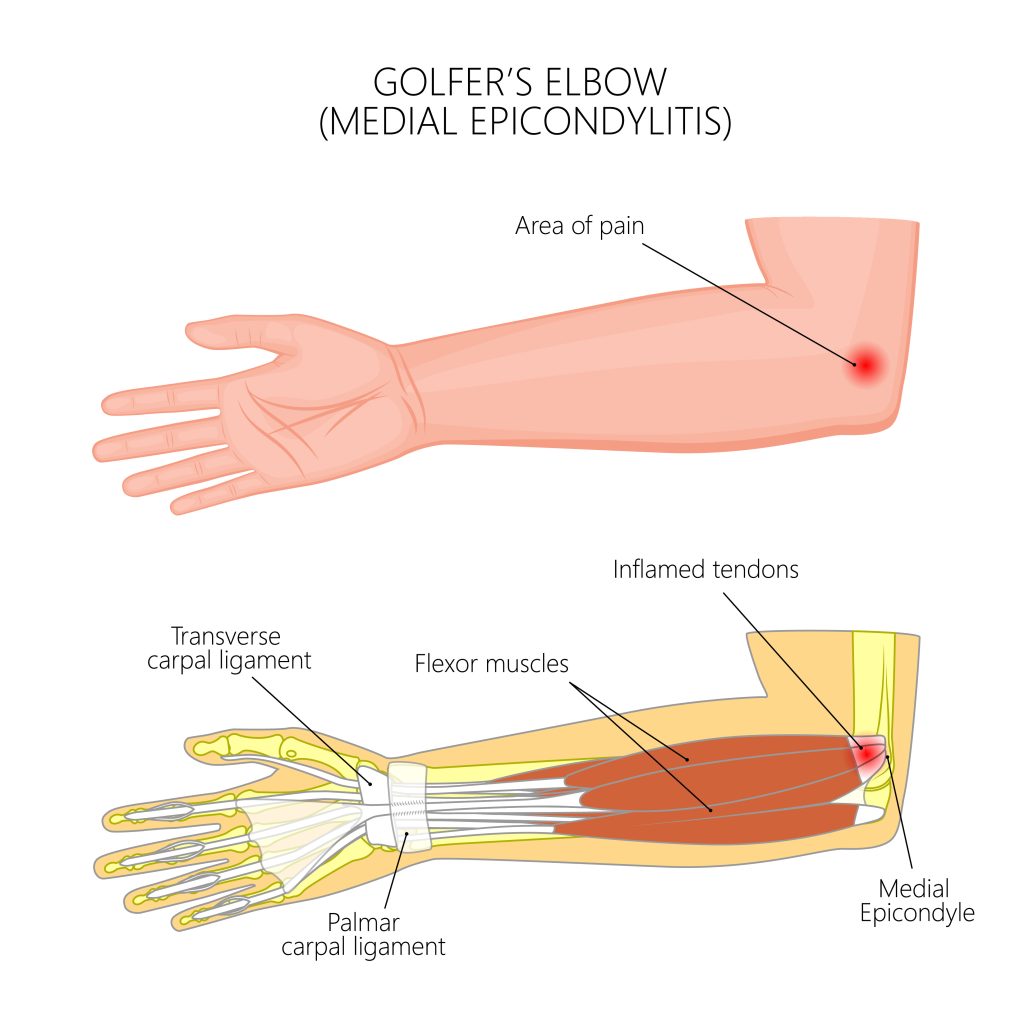
Tennis elbow and golfer’s elbow both affect the tendons in the upper arm. They’re often mistaken for each other but have different causes and symptoms. So, what is the difference between these injuries? And why are they so common in these sports?
Here, you will learn the basics of tennis and golfer’s elbow. Including symptoms, causes, treatment, and diagnosis. We’ll also provide tips on preventing elbow injuries so that you can stay injury-free on the court! Take a look at this article to learn everything you need about this condition!
In what ways are tennis elbow and golfer’s elbow different?

Generally, these two are overuse injuries that occur due to repeated trauma. The results of such repeated impacts are microscopic tears in the tissue. This results in swelling, inflammation, and pain around the elbow.
It’s easy to decode these technical terms. Lateral and medial is a medical term for “outer” and “inner”. Epicondylitis is an inflammation that surrounds an epicondyle. An epicondyle is a bump located above a long bone’s condyle. Inflammation of the outer elbow is otherwise known as tennis elbow. On the other hand, golfer’s elbow is an inflammation of the inner elbow. In this sense, tennis and golfer’s elbow are two different forms of elbow epicondylitis.
What is tennis elbow?
Tennis elbow is also called lateral epicondylitis. The tendons extend and stabilize the wrist as they anchor your muscles to your bones. It includes the muscles that bend your wrist backward and straighten your fingers. When the attachment site weakens, you experience pain and tenderness. The pain is usually felt in activities like opening jars or carrying heavy bags. Or while engaged in gripping, grasping, or lifting activities.
The name “tennis elbow” comes from its frequent occurrence among tennis and racquet sports player. They overuse their forearms during activities like throwing or serving a ball.

Symptoms of tennis elbow
Tennis elbow symptoms usually develop gradually. It starts with mild discomfort and worsens with time.
There are several symptoms associated with tennis elbow, including:
- Having difficulty picking up or grasping objects
- Wrist pain during and after activities
- The fingers feel numb or tingly
- The sensation of a dull ache when you rest
- A sharp pang occurs during elbow-related activities
To further confirm your symptoms, try to perform these special tests:
- Mill’s Test: Straighten out your arm and feel the lateral epicondyle. The wrist should be fully bent. Turn your forearm over. If it hurts, this is a positive sign.
- Cozen’s Test: Make a fist with your elbow in 90 degrees flexion. Then, deviate your wrist radially with the forearm pronated. Pain in the lateral epicondyle indicates a positive sign.
- Tinel’s Sign: Use a neurohammer to lightly tap on the inside of your elbow over the ulnar nerve. If testing causes paresthesia without pain, it is a positive sign. A negative sign helps rule out cubital tunnel syndrome or other neurological problems.
What is golfer’s elbow?

Medial epicondylitis is also known as golfer’s elbow. This condition occurs when golfer’s grip a golf club or lift heavy weights repetitively. Rotating the wrist, tightening the fingers, and gripping your muscles directly affect the tendon. You use these muscles to flex your wrist and close your fingers into a fist. Inflammation and small tears occurs in the tendon attached to the medial condyle. The medial condyle is a bony bump inside the elbow.
Symptoms of golfer’s elbow
A golfer’s elbow will undoubtedly cause some or all of these symptoms:
- Your hand or wrist is weak
- Radiating pain down your arm from the inside of your elbow
- Pain when gripping or twisting objects
- Pain when flexing your wrist
- Ring or little finger feels numb and tingly
To further confirm your symptoms, try to perform these special tests:
- Golfer’s elbow test: Simultaneously pronate and flex your wrist and forearm. Turn your palm from up to down and bend your wrist backward. A positive result will occur when you feel pain over the attachment of the wrist flexor muscles.
When to refer to a specialist
- If you suffer from severe pain or functional impairment.
- Despite six to twelve months of treatment in primary care, symptoms have not improved.
- Observe the patient for six weeks. Re-evaluate the diagnosis if no response is evident.
Conservative treatment
- Restricted activity: Limit and avoid activities that aggravate your symptoms.
- You can reduce pain and swelling by applying ice to the affected area. Use ice packs over a towel, never directly on the skin.
- Over-the-counter anti-inflammatory medicines can help reduce pain. Stick to the recommended doses. You should go to the doctor is the pain doesn’t go away.
- Proper warm-ups and hydration: Drink lots of water throughout the day. Include the right kind of stretching in your warm-up routine to prepare your body.
- Correct your form: If bad form causes your problem, you might want to work on your technique. Alter your grip technique or select a different size grip. Whether it’s a tool or a golf club, changing it can make a difference.
Physical Therapy
- A health care provider will perform athletic taping to reduce tenderness in the area.
- If you need a more sturdy way to relieve strain, your doctor may recommend you wear a brace or wrist splint. Braces exert pressure on the muscles below the elbow. It allows you to engage in regular activities with minimal activity. You should wear braces during the day and remove them before bedtime.
- Pulsed Ultrasound: This non-invasive treatment promotes healing. It promotes blood flow to injured tendons and breaks up scar tissue.
- TENS Device: Transmits electric impulses through the skin to the nervous system. This device prevents pain signals from reaching the brain.
- During laser therapy, concentrated light beams stimulated blood circulation and body metabolism.
- Massage techniques can boost your body’s blood flow and healing process. It stimulates a quicker natural recovery.
Tennis elbow exercises
- Wrist extension: Place your palm face down on a flat surface. Extend your wrist as high as you can. You may hold a dumbbell to assist with strengthening your wrist.
- Wrist flexion: Your palm should be facing upward in this exercise, as opposed to a wrist extension.
- Grip strengthening: Squeeze a stress ball for at least a few seconds at a time to strengthen your grip.
Golfer’s elbow exercises
- Isometric wrist strengthening: Use your other hand for resistance. Then, lower and raise your wrist. Do this with your palm facing either up or down.
- Resisted wrist extension: Hold a lightweight dumbbell with your palm. Your palm should be facing down over the edge of a flat surface. Lower your hand slowly then raise them back again.
- Resisted wrist flexion: Similar to resisted wrist extension. But, hold your dumbbell with your palm facing upward.
- Golfer’s elbow stretch: Put your arms straight with your arms facing upward. Then, pull your fingers down toward your body.
Intensive Treatment
- Cortisone injections reduce pain and inflammation. But, it can weaken sensitive tissues with long-term use. The injections are given near the elbow’s tendons and sore spots.
- Platelet rich plasma (PRP) – “Blood spinning” therapy is another option. Many professional athletes use it. This method involves spinning your blood in a centrifuge. It concentrates the platelets to help you heal faster.
- Dry needling aims to minimize pain perception by puncturing the tendon. It releases tightness, eases inflammation, and promotes healing.
Surgery
Surgery for epicondylitis may be necessary in severe cases. It involves repairing torn tendons or releasing the pressure on the tendon. During some weeks, your activities will be limited. It is especially advisable to avoid activities other than light exercise.
Is there any long-term effect on tennis elbow and golfer’s elbow?
The elbow may lose its full range of motion if you don’t receive proper treatment. If this happens, surgery may be necessary to reverse the effects.
How to avoid elbow injuries?
Patients often have to change the activities that caused their elbow injury. Another way to avoid elbow injuries is to take steps to keep them from happening again.
- To prevent an overuse injury, avoid overusing specific tendons or muscles.
- Stretch before engaging in a sport that requires repetitive arm movements. This helps to get your blood flowing.
- It is possible to prevent injuries by using the correct form.
- You can prevent tennis elbow and golfer’s elbow by strengthening your forearm muscles.
- Make sure you vary your workout routine to prevent staining your elbow tendons. Whenever possible, include exercises that do not require you to use your elbows a lot.
Conclusion:
If you suspect you have a tennis elbow or golfer’s elbow, you should see a doctor to be sure. These other conditions may require different treatment and can be more serious.



